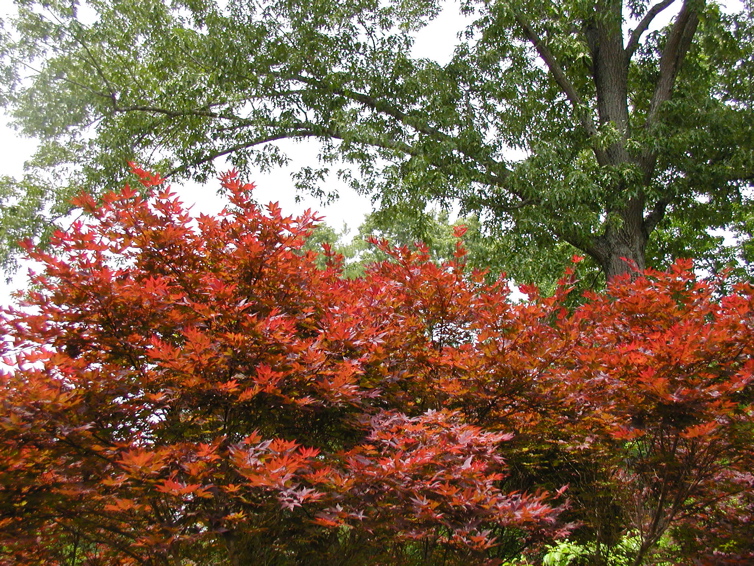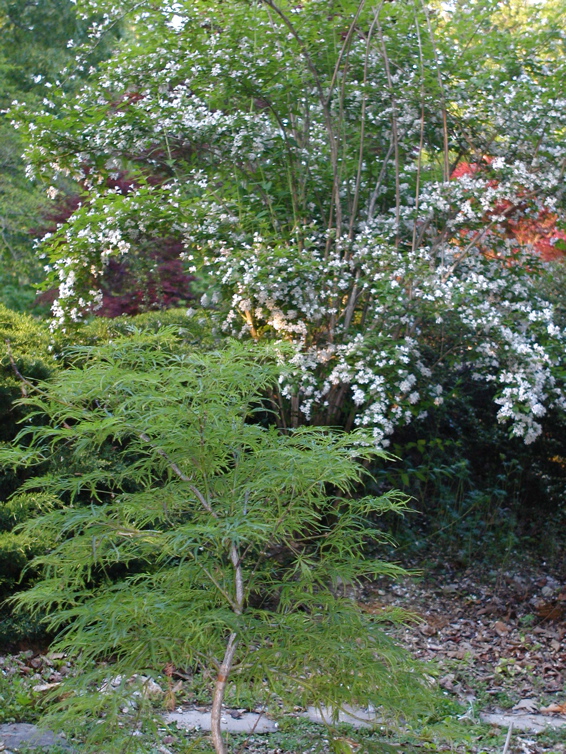Japanese Maples in My Garden
 Monday, February 15, 2010 at 6:00AM
Monday, February 15, 2010 at 6:00AM Japanese maples, acer palmatum, are featured throughout my garden. They are wonderful trees, and I went on a planting spree after the 1990 tornado destroyed many of the trees on our property. The word palmatum tells us what the leaves look like. They have five to nine pointed lobes with some cultivars having delicate, lace-like leaves. clockwise from top left: fall foliage 'Seiryu', an upright green threadleaf; 'Orido Nishiki', a variegated which has reverted to all green; unnamed variety; 'Butterfly'
clockwise from top left: fall foliage 'Seiryu', an upright green threadleaf; 'Orido Nishiki', a variegated which has reverted to all green; unnamed variety; 'Butterfly'
If you look closely in the spring, you may see lovely flowers with red or purple sepals. They produce small fruit, called samaras, which have a pair of wings.
Japanese maple have been cultivated in Japan for centuries, and there are hundreds of named cultivars. In Japan these trees are called "Momiji", which means changing colors. Colors range from chartreuse to gold to dark green, from red to purple, to variegated white, green, and pink. The brighter reds and purples may soften to softer rose or green shades in summer. Bright red, burgandy, orange, and gold tones appear for fall, and these color variations can be spectacular. Sometimes I think I have too many of the red ones, for in the spring my garden is saturated with color. It's almost too much, and I am glad when the more subdued tones of summer arrive.
The seedlings may be quite different from the parents. A number of the Japanese maples in my yard were unnamed seedlings, and some of them are as beautiful as any named variety I have seen.  This brilliant foliage is from an unnamed Japanese maple. It was a small seedling when I planted it.My own trees are now producing babies, which I give away as gifts. I tell people to keep them in pots for a few years, until they are large enough to go into the garden.
This brilliant foliage is from an unnamed Japanese maple. It was a small seedling when I planted it.My own trees are now producing babies, which I give away as gifts. I tell people to keep them in pots for a few years, until they are large enough to go into the garden.
Grown in zones 5 to 8, cultivars vary from shrubs about eighteen inches tall to trees growing to twenty-five tall and wide. Their crowns may be rounded, weeping, or vase-shaped. They have a slow to moderate growth rate and like well drained, rich soil. They need to be well watered in their early years, but soggy soil can kill one of these tree. They should be pruned in fall after the leaves have fallen.
Their natural habitat is in the understory of woodlands.The red leafed varieties can usually take more sun, while the variegated ones need the protective cover of larger trees. Excess sun, wind or drought will cause leaf scorch. Most of my red Japanese maples are planted in full sun, but they were seedlings locally grown, so I think they have adapted well to our hot summer sun. Many of my Japanese maples had crispy leaves during our extended drought a couple years ago. Last year the rains returned, and there was no problem. A variegated Japanese maple "Butterfly" was about four feet tall when I planted it. It received hot sun for several hours a day, and despite my best efforts, it did not survive the drought. It was a gorgeous tree, and I think I will plant another one, but in a much shadier spot this time.
Some other Japanese maples I have in my garden:Another unnamed variety has fantastic gold fall foliage.
 'Orido Nishiki' in the fall
'Orido Nishiki' in the fall 'Waterfall'
'Waterfall'
 Sold to me as 'Nishiki Gawa', but not what it is! It is a weeping tree with fine green leaves, tinged with pink in spring.
Sold to me as 'Nishiki Gawa', but not what it is! It is a weeping tree with fine green leaves, tinged with pink in spring. This shows the great structure of our 'marriage tree'.
This shows the great structure of our 'marriage tree'.Another unnamed seedling, grown into a beautyThese great trees have year-round appeal, and the larger ones probably deserve their hefty price tags. As you can see, however, even the unnamed seedling can grow into a fabulous specimen. While it has taken my seedlings twenty years to reach their present size, they were beautiful even when small. I have never done it, but Japanese maples are excellent specimens for bonsai, and many varieties do well in pots.
So, if you have the right climate, there's bound to be a Japanese maple for you!
 Japanese maple in
Japanese maple in  plants,
plants,  trees
trees
Reader Comments (21)
What a stunning collection you have ... they are so beautiful! I particularly love your three unnamed varieties ... terrific colours! Just wish I could grow these ... ah well!
Beautiful presentation, Deborah! They are interesting in every season.
I can see where these beauties would fit perfectly into my garden. I might not live long enough to see them to such a stunning size, but the small specimens are beautiful.
You have a delightful collection. The colors are wonderful.
Wow! Those are so beautiful. You have quite a variety and pretty colors.
What a beautiful collection of them!! They are my favorite tree, they add so much interest year round. We have 'Orido Nishiki' too and right now all the branches are bright red.
Deborah, they are all beautiful. I wish that they were hardier in Owen Sound. I have planted three this summer, will keep my fingers crossed!
Hi Deb,
I love your Japanese maples (especially Waterfall and the Marriage Tree) and your Lady Garden is fabulous. I look forward to seeing the growth as spring unfolds.
Deb, These are beautiful. I never think of planting trees in my garden because my property is so heavily wooded (including with native maples), but it certainly would be lovely to have one or two of these. -Jean
Wow! I love your Japanese maples, Deb! These were near and dear to my heart when I lived in Zone 7. How I miss them! Thanks for sharing yours in this wonderful post! They really make your garden.
P.S. I just added you to my blogroll. Didn't know I could before, since you weren't on blogger. But I missed reading your posts on Blotanical, so I figured it out! LOL
These are such stunning trees - I'd really love to get some for here once things are a bit more developed... I have a terrible habbit of buying plants and then deciding on where I should put them!! Thanks for sharing the lovely photos... Miranda
What a beautiful collection of Japanese maples you have Deborah! I really like the one with the gold foliage - I'm not sure that I've ever seen one with such a clear golden colour!
I have a couple of unamed ones in my garden and they seem to have tolerated all but the hottest and driest weather in my garden (last summer was tough on them!)
thanks for such an interesting and informative post on one of my favourite trees :) Heidi
I love the fact that you celebrated your marriage with an elegant slow growing tree, potted it, moved it, and eventually planted it. What a beautiful way to say "we are one". All of these pictures of your Japanese maples are gorgeous, but my favorite is your marriage tree!
Wot a lovely post.
LOve the woodland feel of your garden.
You really love your trees and shrubs don't you?
Especially struck by the airy lightness of Orido Nishiki and the wonderful structure of your marriage tree.
Great to be able to reaccess blotanical after a few days without it!
Best Wishes
Robert
Deb,
I so enjoy the beauty offered by Japanese Maples. They were a common sight while I lived in the Pacific Northwest, and I miss them so since moving to Vermont. I am growing a couple varieties, and keep my fingers crossed that they will thrive despite our harsh winters.
You've got a great collection going.
I've been adding a few at a time to build my own. Seriyu is one of my favorites. It is an upright threadleaf. All my other threadllleaf varieties are weeping.
Since they're expensive, I start with small plants and pamper them for the first year or two as deck plants until they get big enough to go in the ground. That way I build a relationship with them!
Beautiful post.
The one with gold fall color really looks like Sango Kaku the coral bark maple. Does it have really beautiful orange red winter twigs?
Your Shishigashira definitely looks like Seriyu. It is so easy to get tags mixed up on nursery stock.
Shishigashira means lion's head or lion's mane and the leaves are crinkled and arranged in tufts. I don't have that one but have been admiring it on the internet and considering adding it to my collection.
The leaves in your picture do look like Seriyu but the real clue would be the growth habit. Seriyu is very upright. The branches come off the trunk at about a 45 degree angle and so the canopy is narrow for a Japanese maple.
I love a plant mystery!
Hi Deb - lovely trees and nice presentation. I can only admire these from afar. We still have the snow that will not go away -
Wow, I'm impressed with your collection! I love Japanese Maples & have a few that I've just put in over the last few years. Can't wait to have little seedlings to give away.
Your collection of Japanese maples is so awesome! I really want one, but I shy away because they're so expensive, and I'm worried they won't do well for me. I have so much sun on my property, as well as a lot of wind. I'd have to plant near to my house.
Awesome trees. I can't believe how big they are in in only 10 short years. I think they can never be too much and spring at your place must be awesome.
Dear Deb!
Your maples are beautiful and the hole garden too. I bought an 'Orido Nishiki' yesterday. I would like to asking that your Orido Nishiki' s shape is naturally or it has formed by pruning? I' m asking it because I see other pictures and all of those show funnel(?) shape. I like much better the tree habit of yours and of course I would like to growing tree like yours.
Sorry my english. I just hope that it was understandable.
Greetings Meli from Hungary.